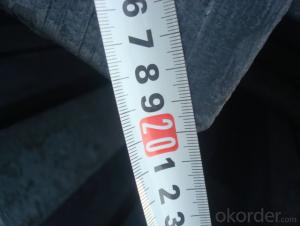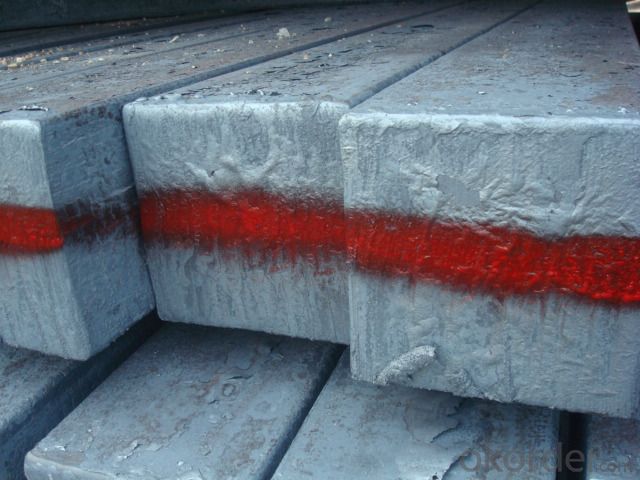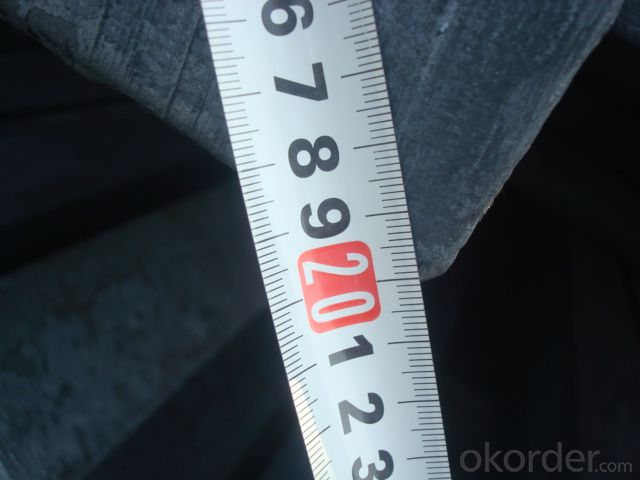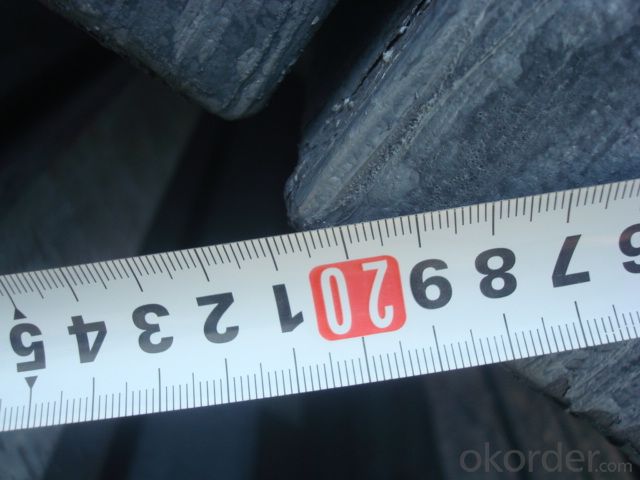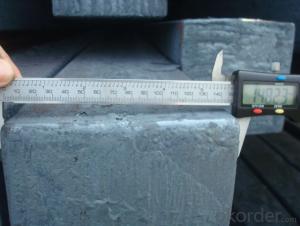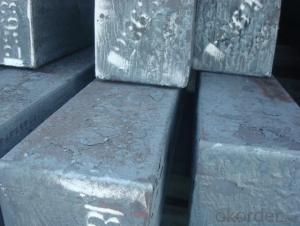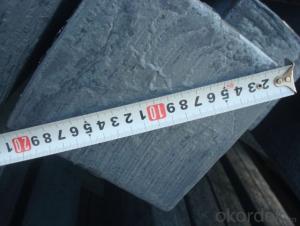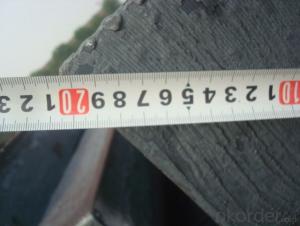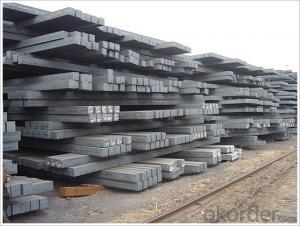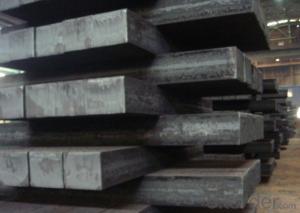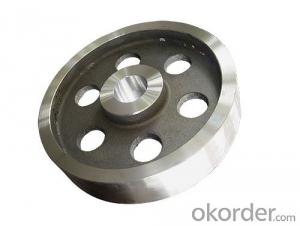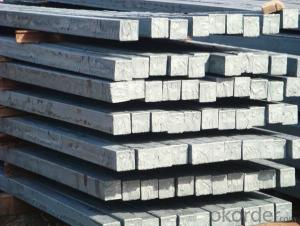Steel Billet Hot Rolled Q245 in Amazing Price
- Loading Port:
- Tianjin
- Payment Terms:
- TT OR LC
- Min Order Qty:
- 1000 m.t.
- Supply Capability:
- 50000 m.t./month
OKorder Service Pledge
OKorder Financial Service
You Might Also Like
1.Structure of Steel Billet
Steel billet(ingot) by cogging or breakdown of semi-finished products, is the raw material of all kinds of steel mill. Billet section of square, round, flat, rectangular and abnormity of several kinds of, mainly related to the shape of rolled products.
2.Main Features of Steel Billet
Rectangular billet continuous casting billet and mainly general carbon steel, low carbon low silicon cold-rolled material, high quality carbon structural steel, high strength low alloy steel, special steel, etc.
The billet is mainly divided into two kinds from the shape:
Slab: cross section width and height of the ratio of the larger, mainly used for rolling plate.
Billet: equal cross section width and height, or a huge difference, mainly used for rolling steel, wire rod. ,
Steel billets have distinct characteristics as compared with already furnished steel bars and products. Billets have a specific grain structure, which enables the metal to be processed more intricately. Steel billets are also known for their malleability and ductility, especially when exposed to varying temperatures during shaping and molding.
3.Processing of Steel Billet
Steel billets are considered fresh and raw, and they must undergo a series of manufacturing processes before they can be used for various purposes. Billets are made by means of freezing molten liquid, and are later exposed to extremely low temperatures in order to allow the metal to take shape and solidify in chemical structure. The temperature manipulates the metal's physical properties, and tones its strength and durability. The subsequent processes provide the metal's curved mold design so that it can fit the allotted space provided by other machines, which complete the finishing procedures.
4.Steel Billet Images

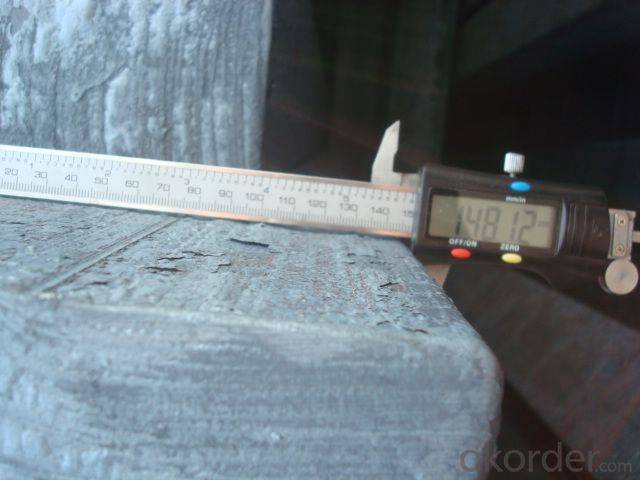
5. Steel Billet Specification
Hot rolled billet steel
Size: 50x50mm-180x180mm
Steel Grade: 3SP, 5SP,Q195,Q235,Q255,Q275 Length:3m-12m
MOQ: 1000MT/size
Payment term: TT or LC
Packing: in bulk , bundle
Shipment: by container , bulk vessel
Packaging Details: bundles with steel strips or as customers's requirements
Delivery time: 15-30 days after the deposit
Loading port:Tianjin, or other port China
Origin :China
Inspection:Third party inspection before loading.
6.FAQ
We have organized several common questions for our clients,may help you sincerely:
1) How about your company?
A world class manufacturer & supplier of castings forging in carbon steel and alloy steel,is one of the large-scale professional investment casting production bases in China,consisting of both casting foundry forging and machining factory. Annually more than 8000 tons Precision casting and forging parts are exported to markets in Europe,America and Japan. OEM casting and forging service available according to customer’s requirements.
2)Do you have your own QC department?
Yes, we have, our QC department will inspect the goods during the process of mass production and after completion of production.
3) Can you guarantee the quality of mass production?
Yes, of course. We will send pre-production samples to you for confirmation, after your confirmation we will start mass production. The quality of mass production will be the same as the samples you confirmed to us.
- Q: How are steel billets used in the manufacturing of pipeline fittings?
- Pipeline fittings rely on steel billets, an essential component in their manufacturing process. These fittings have the purpose of connecting and regulating the movement of fluids or gases within pipelines. To begin the utilization of steel billets for pipeline fittings, the initial step entails selecting durable and high-quality steel. Typically, low carbon steel is chosen for billet production due to its strength and resistance against corrosion. Once the appropriate steel billets are chosen, they undergo heating in a furnace to reach a specific temperature known as the forging temperature. This temperature renders the steel malleable, allowing it to be shaped into various forms. Subsequently, the heated steel billets are placed into a forging press, where they are subjected to immense pressure. This pressure causes the steel billets to deform and acquire the desired shape and size. This process, known as forging, guarantees the strength and integrity of the pipeline fittings. Following the forging process, the steel billets undergo further processing to achieve the final shape required for the pipeline fittings. This may entail additional procedures such as machining, welding, or others, depending on the specific fitting requirements. Once the final shape is achieved, the fittings undergo thorough quality inspections and a variety of tests to ensure compliance with industry standards. These tests comprise dimensional checks, non-destructive testing, pressure testing, and more. Upon successfully passing all necessary tests, the pipeline fittings are ready for installation. These fittings are of paramount importance as they play a crucial role in connecting different sections of the pipeline, enabling the controlled flow of fluids or gases. They provide a secure and leak-free connection, ensuring the safe and efficient operation of the pipeline system. In conclusion, steel billets undergo a series of processes including heating, forging, machining, and testing to manufacture pipeline fittings. These fittings are vital for connecting and regulating fluid or gas flow within pipelines, ensuring the safe and efficient operation of the entire system.
- Q: What are the main factors affecting the dimensional accuracy of steel billets?
- The dimensional accuracy of steel billets can be influenced by several key factors. To begin with, the casting process's temperature is of utmost importance. Steel billets are typically cast at high temperatures, and any fluctuations or inconsistencies in temperature can result in dimensional inaccuracies. If the temperature is too high, the billet may expand, leading to dimensions larger than desired. Conversely, if the temperature is too low, the billet may contract, resulting in smaller dimensions than intended. Therefore, it is crucial to maintain a consistent and controlled temperature to achieve dimensional accuracy. Furthermore, the cooling process after casting also impacts the dimensional accuracy of steel billets. Rapid cooling can cause uneven contraction, leading to distortions in dimensions. Conversely, slow cooling can cause excessive growth and expansion of the billet. Hence, it is necessary to carefully control and optimize the cooling rate to ensure uniform and accurate dimensions. Moreover, the design and condition of the casting molds significantly influence the dimensional accuracy of steel billets. The mold should be appropriately designed to accommodate shrinkage and compensate for potential distortions. Additionally, the mold's condition, such as wear and tear or improper alignment, can also contribute to dimensional inaccuracies. Regular maintenance and inspection of molds are essential to ensure proper functioning and minimize any impact on dimensional accuracy. Finally, the composition and quality of the steel itself can affect the dimensional accuracy of the billets. Variations in chemical composition or impurities in the steel can lead to inconsistencies in the cooling and solidification process, resulting in dimensional inaccuracies. Hence, stringent quality control measures and precise composition monitoring are necessary to minimize variations in the steel and maintain dimensional accuracy. In conclusion, temperature control during casting, the cooling process, the design and condition of casting molds, and the composition and quality of the steel are the main factors affecting the dimensional accuracy of steel billets. By closely monitoring and controlling these factors, manufacturers can ensure the production of steel billets with accurate dimensions.
- Q: What are the main factors affecting the heat resistance of steel billets?
- The heat resistance of steel billets can be influenced by several key factors. Firstly, the chemical composition of the steel is crucial. Carbon, chromium, and nickel, for example, can enhance heat resistance by forming stable oxide layers on the surface. These layers act as a protective barrier against high temperatures. Additionally, alloying elements like molybdenum and vanadium can improve heat resistance by increasing hardenability and reducing grain growth during heat treatment. Another important factor is the microstructure of the steel. Fine-grained structures tend to have higher heat resistance due to increased strength and reduced susceptibility to thermal fatigue. Heat treatment processes, such as quenching and tempering, can also alter the microstructure and improve heat resistance. The rate of heating and cooling also plays a role in heat resistance. Rapid temperature changes can cause thermal shock, resulting in cracks or distortion in the billets. Controlling the heating and cooling rates is essential to minimize these detrimental effects and maintain desired heat resistance. Impurities or defects within the steel can significantly impact heat resistance. Inclusions like sulfur, phosphorus, and non-metallic oxides can act as stress concentrators and reduce heat resistance. Similarly, internal defects such as voids, cracks, or segregation regions can promote crack initiation and propagation during thermal cycles, decreasing overall heat resistance. Lastly, the mechanical properties of the steel, such as tensile strength, hardness, and ductility, can influence heat resistance. Higher strength and hardness generally enhance heat resistance, while excessive ductility may lead to deformation or failure under high-temperature conditions. To summarize, the factors affecting the heat resistance of steel billets include chemical composition, microstructure, rate of heating and cooling, presence of impurities or defects, and mechanical properties. Understanding and optimizing these factors can result in steel billets with improved heat resistance for various applications.
- Q: How are steel billets transported and stored?
- Steel billets are typically transported using specialized vehicles such as flatbed trucks or railcars. They are securely loaded onto the transport vehicle using cranes or forklifts. Once transported to their destination, steel billets are usually stored in warehouses or outdoor storage yards. They are often stacked on top of each other, with proper spacing and support to ensure stability. Additionally, to protect against corrosion, steel billets may be coated with a rust-resistant material or stored in a climate-controlled environment.
- Q: How are steel billets used in the manufacturing of medical devices?
- Steel billets are used in the manufacturing of medical devices in various ways. Firstly, steel billets serve as a raw material for the production of surgical instruments, such as scalpels, forceps, and scissors. These devices require a high level of strength, durability, and corrosion resistance, which steel billets can provide. Additionally, steel billets are used in the manufacturing of implants, such as joint replacements and dental implants. These devices need to be able to withstand the load and stress exerted by the human body, and steel billets are an ideal material due to their excellent mechanical properties. Moreover, steel billets are used in the production of medical equipment, such as hospital beds, wheelchairs, and surgical tables. These devices require a sturdy and robust structure, and steel billets can provide the necessary strength and stability. Furthermore, steel billets are also utilized in the manufacturing of medical equipment components, such as brackets, frames, and supports. These components play a crucial role in the functioning and stability of medical devices, and steel billets are often chosen due to their high machinability and weldability. Overall, steel billets are an essential raw material in the manufacturing of various medical devices. Their strength, durability, corrosion resistance, and other mechanical properties make them a suitable choice for producing surgical instruments, implants, medical equipment, and their components.
- Q: What is the typical weight of a steel billet?
- The typical weight of a steel billet can vary depending on its size and purpose. However, a common weight range for steel billets is between 1,000 and 5,000 pounds (450 to 2,270 kilograms). This range allows for flexibility in manufacturing processes and various applications in industries such as construction, automotive, and manufacturing. It is important to note that specific weight requirements may vary depending on the intended use and specifications of the steel billet.
- Q: How are steel billets used in the production of shafts?
- Steel billets are used in the production of shafts by being heated and then forged or machined into the desired shape and size. The billets serve as the raw material from which the shafts are formed, providing the necessary strength and durability required for various applications such as automotive, machinery, and construction industries.
- Q: Can steel billets be used in the production of sculptures and artwork?
- Yes, steel billets can be used in the production of sculptures and artwork. Steel's strength and durability make it a popular choice for creating large outdoor sculptures or intricate metal artwork. The material can be shaped, welded, and manipulated to bring artistic visions to life, offering artists a versatile medium to express their creativity.
- Q: What are the main factors affecting the hardenability of stainless steel billets?
- The hardenability of stainless steel billets, which refers to the material's ability to be hardened through heat treatment, can be influenced by various factors. These factors include: 1. Alloy composition: The composition of stainless steel, especially the presence of carbon, chromium, nickel, and molybdenum, plays a crucial role in determining its hardenability. Higher carbon content generally improves hardenability, while elements like chromium and nickel enhance corrosion resistance but may decrease hardenability. 2. Grain size: The grain size of stainless steel billets affects the rate and depth of hardening. Finer grain structures typically exhibit better hardenability compared to coarser ones. This is because smaller grains allow for a more even distribution of carbon and alloying elements, resulting in improved hardening response. 3. Heat treatment conditions: The specific heat treatment process utilized, including heating and cooling rates, soaking time, and quenching media, has a significant impact on the hardenability of stainless steel billets. Proper control of these parameters is essential to achieve the desired hardness and mechanical properties. 4. Cooling rate: The rate at which the billets are cooled during the quenching process is a critical factor in determining their hardenability. Rapid quenching, such as water or oil quenching, promotes martensitic transformation and leads to greater hardness. Slower cooling rates, such as air cooling, result in a softer and less hardened structure. 5. Cross-sectional thickness: The thickness of the stainless steel billets also affects their hardenability. Thicker sections tend to have lower hardenability due to slower heat transfer rates during quenching. Conversely, thinner sections can achieve higher hardness levels due to faster cooling rates. 6. Prior microstructure: The initial microstructure of the stainless steel billets, whether they are in an annealed or cold-worked state, can influence hardenability. Cold work can introduce dislocations and grain boundaries, which may impede the diffusion of carbon and alloying elements during heat treatment, leading to reduced hardenability. Considering these factors, manufacturers and engineers must carefully select stainless steel grades and tailor the heat treatment process to achieve the desired level of hardenability and mechanical properties in stainless steel billets.
- Q: What are the weight ranges of steel billets?
- The weight ranges of steel billets can vary depending on the specific requirements and standards of the industry. However, typically, steel billets can range anywhere from a few kilograms to several metric tons in weight. The weight of a steel billet is determined by factors such as its dimensions, intended application, and production process. For smaller steel billets, such as those used in construction or manufacturing, the weight range may be between 1 to 10 kilograms. On the other hand, larger steel billets, commonly used in heavy machinery or infrastructure projects, can range from 10 to 100 metric tons or even more. It is important to note that these weight ranges are general estimates and can vary based on specific industry requirements and production capabilities.
Send your message to us
Steel Billet Hot Rolled Q245 in Amazing Price
- Loading Port:
- Tianjin
- Payment Terms:
- TT OR LC
- Min Order Qty:
- 1000 m.t.
- Supply Capability:
- 50000 m.t./month
OKorder Service Pledge
OKorder Financial Service
Similar products
Hot products
Hot Searches
Related keywords

